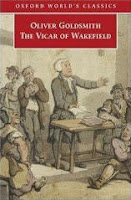2007 TBR Challenge #5
My 100th post!
 This novel recounts the ups and downs (or to be more accurate, the many downs and then the ups) of the Primrose family, whose patriarch is the titular vicar. When the man with whom they have invested their savings absconds under a cloud of bankruptcy, the Primroses are obliged to remove to another town and embark on a more frugal life. This proves to be only the first in a string of disasters, not the least of which is their acquaintance with Mr Thornhill, their landlord and an unscrupulous rake with his eye on both the Primrose daughters. A swindler, a fire, debt, abduction, dishonour and imprisonment all follow on the heels of their original bad fortune before luck is restored by the schemes of conman Ephraim Jenkinson and a healthy dose of coincidence. All helped along, of course, by the goodnaturedness of the family, which gets its reward in the end.
This novel recounts the ups and downs (or to be more accurate, the many downs and then the ups) of the Primrose family, whose patriarch is the titular vicar. When the man with whom they have invested their savings absconds under a cloud of bankruptcy, the Primroses are obliged to remove to another town and embark on a more frugal life. This proves to be only the first in a string of disasters, not the least of which is their acquaintance with Mr Thornhill, their landlord and an unscrupulous rake with his eye on both the Primrose daughters. A swindler, a fire, debt, abduction, dishonour and imprisonment all follow on the heels of their original bad fortune before luck is restored by the schemes of conman Ephraim Jenkinson and a healthy dose of coincidence. All helped along, of course, by the goodnaturedness of the family, which gets its reward in the end.
The plot was of the most straightforward variety, and proved that whoever Murphy was, his law was alive and well in 1760s fiction. Every disaster that could befall the family, proceeded to do so, until it began to verge on the melodramatic. But it managed to skirt this fate, just as - for the most part, at least - it avoided becoming a morality tale. The exception was the chapter composed solely of an address by the vicar to the inmates of a debtors’ prison. Fortunately it was short, although the reforms he wrought in the place seemed rather too good to be true.
The best part, to my mind, was the ending, where matches were made, imprisonments reversed, fortunes restored, and identities revealed. It could have all been a bit too neat but the coincidences were accounted for and it was fun to see the villain brought down by his own co-conspirators. And such a lovely fate for him! Guaranteed to put a crimp in his style. The final schemes cemented Jenkinson’s place as my favourite character of the bunch, ahead of the vicar’s wife with her little touches of vanity and the vicar himself. He had just about the patience of a saint in dealing with all their misfortunes, but enough small flaws to prevent him from being irritatingly perfect. This is perhaps one for the classics fans, but one worth reading.
Rating: B-

















No comments:
Post a Comment